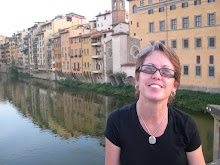We woke this morning to the church bells in Campo San Apostoli at 7am and had breakfast in our room. After a hot shower and re-packing our suitcases, which we left with Stefano at the hotel, we set out for the Accademia where we viewed several rooms of religious paintings. Of particular note were several paintings I had studied in Art History in college. To say the pictures in our books did not do these works justice is an understatement. Upon entering the first sala you are faced with Palo Veneziano's “Polittico.” There was a group of students gathered around listening to a lecture by their professor. Mr. Man and I tried to ease drop as much as possible, and I experienced a moment of envy of their being fortunate to study art in a place with such history.
We also saw Lorenzo Veneziano’s “Polittico Leon Con l’Annunciazione,” Michelle Giambono’s “Incoronazione della Vergene in Paradiso,” which was rich in color and texture, which does not come across in photographs. Each crown, staff and embroidery/embellishment on the robes was glimmering gold and raised. There was a particularly good restoration completed on Vittore Carpaccio’s “The Presentation of Jesus in the Temple” rich color, each fold in cloth so realistic, shimmering of satin; the face of Mary and her maids so serene and peaceful, and perhaps, a bit resigned? We gave each painting the time and contemplation it deserves, but we also wanted to visit the Jewish Ghetto.
We jumped on a vaporetta and headed for San Marcuola. There are only thirty Jews who currently live in the ghetto, and only about 400 Jews in all of Venice. Once we found the ghetto, we visited the Jewish Museum and took a tour of three synagogues (all in the ghetto, and all only used, symbolically, once a year). The first synagogue was built in 1516 by German immigrants and is thus referred to as the German Synagogue. It is very small with a beautiful, ornate gold Bimah, faux marble walls (marble is too heavy for walls on the upper floors), and a balcony where the women sit. This synagogue is only used on Erev of Rosh Hashanna. Three years after it was built, a group of French Jews built a second synagogue next door, which is now attached as part of the museum. This is no larger than the first, is paneled in rich wood and frescoes of the Exodus. There is also a gallery above for women. Because of its position on a corner it is called the “Canton” Synagogue. The third synagogue is the Italian Synagogue, who don’t consider themselves Ashkenazi nor Sephardic Jews—just Italian. In the Italian Synagogue the Bimah is raised. We were unable to visit the synagogues currently in use on a regular basis as they were preparing for Yom Kippur, as well as the Sabbath in a couple of hours. There was a viewing from outside, but we skipped this as it had begun to rain again and we needed to start heading back to retrieve our luggage and head to Rome.
We also saw Lorenzo Veneziano’s “Polittico Leon Con l’Annunciazione,” Michelle Giambono’s “Incoronazione della Vergene in Paradiso,” which was rich in color and texture, which does not come across in photographs. Each crown, staff and embroidery/embellishment on the robes was glimmering gold and raised. There was a particularly good restoration completed on Vittore Carpaccio’s “The Presentation of Jesus in the Temple” rich color, each fold in cloth so realistic, shimmering of satin; the face of Mary and her maids so serene and peaceful, and perhaps, a bit resigned? We gave each painting the time and contemplation it deserves, but we also wanted to visit the Jewish Ghetto.
We jumped on a vaporetta and headed for San Marcuola. There are only thirty Jews who currently live in the ghetto, and only about 400 Jews in all of Venice. Once we found the ghetto, we visited the Jewish Museum and took a tour of three synagogues (all in the ghetto, and all only used, symbolically, once a year). The first synagogue was built in 1516 by German immigrants and is thus referred to as the German Synagogue. It is very small with a beautiful, ornate gold Bimah, faux marble walls (marble is too heavy for walls on the upper floors), and a balcony where the women sit. This synagogue is only used on Erev of Rosh Hashanna. Three years after it was built, a group of French Jews built a second synagogue next door, which is now attached as part of the museum. This is no larger than the first, is paneled in rich wood and frescoes of the Exodus. There is also a gallery above for women. Because of its position on a corner it is called the “Canton” Synagogue. The third synagogue is the Italian Synagogue, who don’t consider themselves Ashkenazi nor Sephardic Jews—just Italian. In the Italian Synagogue the Bimah is raised. We were unable to visit the synagogues currently in use on a regular basis as they were preparing for Yom Kippur, as well as the Sabbath in a couple of hours. There was a viewing from outside, but we skipped this as it had begun to rain again and we needed to start heading back to retrieve our luggage and head to Rome.
 Posted by
Posted by


No comments:
Post a Comment